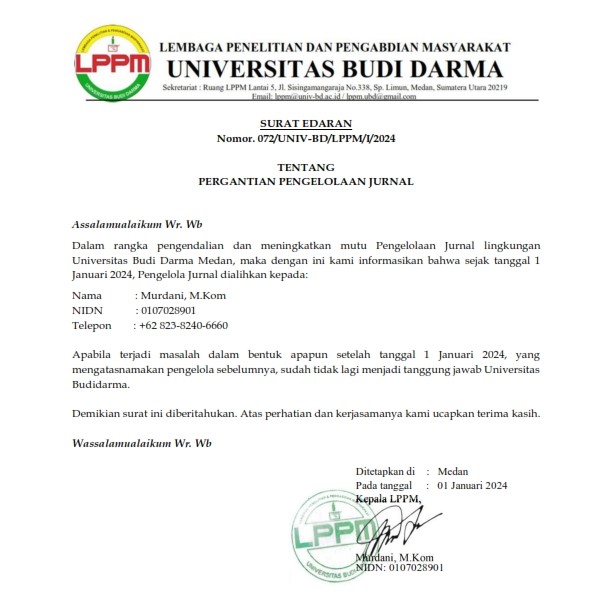Optimasi K-means Clustering Dengan Menggunakan Particle Swarm Optimization Untuk Menentukan Jumlah Cluster Pada Kanker Serviks
DOI:
https://doi.org/10.30865/mib.v7i3.6292Keywords:
PSO-K-Means, K-Means, Number of Clustering, Clustering, Particle Swarm Optimization, Silhouette Coefficients, Davies Bouldin IndexAbstract
Cervical cancer is one of the most common cancers among women in the world. It is most common in developing countries. Cervical cancer develops slowly in the body. Clustering is needed so that cervical cancer can be treated quickly. The K-means method was chosen because of its ability to group large amounts of data and fast computation time. The K-means method is also very easy to implement, flexible, and uses simple principles, which can be explained non-statistically. The many advantages that K-means has, also has weaknesses because it uses random clustering numbers and the results are not optimal. The difficulty in accurately determining the amount of clustering in the dataset. The K-means method cannot provide an optimal solution for determining the number of clustering, so it needs to be improved in order to obtain an optimal solution. PSO was chosen because it has several advantages, namely requiring few parameters, easy to implement, fast convergence, more efficient because it requires little computation and is simple. The results showed that the PSO - K-means method can prove to provide a significant contribution by directly obtaining optimum clustering results without having to do repeated experiments with a Silhouette Coefficient value of 0.83 and a Davies Bouldien Index value of 1.91.References
E. J. Corwin, “Buku Saku Patofisiologi , Handbook Of Pathophysiology,†3. pp. 839–842, 2009.
N. Octavinna, A. Zuhratun, and A. Y. Chaerunnisa, “Aktivitas Senyawa Aktif Michelia champaca Sebagai Inhibitor Topoisomerase Antikanker,†J. Farmaka, vol. 16, no. 3, pp. 213–221, 2018.
N. Kashyap, N. Krishnan, S. Kaur, and S. Ghai, “Risk Factors of Cervical Cancer: A Case-Control Study,†Asia-Pacific J. Oncol. Nurs., vol. 6, no. 3, pp. 308–314, 2019, doi: 10.4103/apjon.apjon_73_18.
I. Rasjidi, “Epidemiologi Kanker Serviks,†Indones. J. Cancer, vol. 3, no. 3, pp. 103–108, 2009, doi: 10.33371/ijoc.v3i3.123.
S. Sherly and M. M. Yunita, “Optimisme Pada Wanita Penderita Kanker Payudara Berusia Dewasa Tengah,†J. Muara Med. dan Psikol. Klin., vol. 1, no. 1, p. 40, 2021, doi: 10.24912/jmmpk.v1i1.12062.
L. A. Torre, F. Bray, R. L. Siegel, J. Ferlay, J. Lortet-Tieulent, and A. Jemal, “Global cancer statistics, 2012,†CA. Cancer J. Clin., vol. 65, no. 2, pp. 87–108, 2015, doi: 10.3322/caac.21262.
P. R. Evriarti and A. Yasmon, “Patogenesis Human Papillomavirus (HPV) pada Kanker Serviks,†J. Biotek Medisiana Indones., vol. 8, no. 1, pp. 23–32, 2019, doi: 10.22435/jbmi.v8i1.2580.
N. F. Adani et al., “Implementasi Data Mining Untuk Pengelompokan Data Penjualan Berdasarkan Pola Pembelian Menggunakan Algoritma K-Means Clustering Pada Toko Syihan,†no. x, pp. 1–11, 2019.
U. Syafiyah, I. Asrafi, B. Wicaksono, D. P. Puspitasari, and M. Sirait, “Analisis Perbandingan Metode Cluster Data Indikator Ketenagakerjaan di Jabar2020……………………………………,†vol. 2020, pp. 803–812, 2020.
A. Hakim and A. Hamid, “Performance Analysis of Hierarchical and Non- Hierarchical Clustering Techniques,†vol. 9, no. 2, pp. 54–71, 2020.
D. Missa, S. Achmadi, and A. Mahmudi, “Penerapan Metode Clustering Dengan Algoritma K-Means Pada Pengelompokan Data Penghasilan Orang Tua Siswa,†JATI (Jurnal Mhs. Tek. Inform., vol. 5, no. 1, pp. 125–133, 2021, doi: 10.36040/jati.v5i1.3275.
Z. Wang, A. Xu, Z. Zhang, C. Wang, A. Liu, and X. Hu, “The parallelization and optimization of K-means algorithm based on spark,†15th Int. Conf. Comput. Sci. Educ. ICCSE 2020, no. Iccse, pp. 457–462, 2020, doi: 10.1109/ICCSE49874.2020.9201770.
I. B. G. Sarasvananda, R. Wardoyo, and A. K. Sari, “The K-Means Clustering Algorithm With Semantic Similarity To Estimate The Cost of Hospitalization,†IJCCS (Indonesian J. Comput. Cybern. Syst., vol. 13, no. 4, p. 313, 2019, doi: 10.22146/ijccs.45093.
Y. Li and H. Wu, “A Clustering Method Based on K-Means Algorithm,†Phys. Procedia, vol. 25, pp. 1104–1109, 2012, doi: 10.1016/j.phpro.2012.03.206.
S. I. Murpratiwi, I. G. Agung Indrawan, and A. Aranta, “Analisis Pemilihan Cluster Optimal Dalam Segmentasi Pelanggan Toko Retail,†J. Pendidik. Teknol. dan Kejuru., vol. 18, no. 2, p. 152, 2021, doi: 10.23887/jptk-undiksha.v18i2.37426.
A. Perdana, “Analisis Perbandingan Metode Genetic Algorithm dan Particle Swarm Optimization dalam Menilai Tingkat Optimasi Hasil Pada Bin Packing Problem Satu Dimensi,†Pros. SNASTIKOM 2017, pp. 1–6, 2017.
J. Karimov and M. Ozbayoglu, “Clustering Quality Improvement of k-means Using a Hybrid Evolutionary Model,†Procedia Comput. Sci., vol. 61, pp. 38–45, 2015, doi: 10.1016/j.procs.2015.09.143.
P. Bholowalia and A. Kumar, “EBK-Means: A Clustering Technique based on Elbow Method and K-Means in WSN,†Int. J. Comput. Appl., vol. 105, no. 9, pp. 975–8887, 2014.
Y. Fang and J. Wang, “Selection of the number of clusters via the bootstrap method,†Comput. Stat. Data Anal., vol. 56, no. 3, pp. 468–477, 2012, doi: 10.1016/j.csda.2011.09.003.
J. Wang, “Consistent selection of the number of clusters via crossvalidation,†Biometrika, vol. 97, no. 4, pp. 893–904, 2010, doi: 10.1093/biomet/asq061.
Downloads
Published
Issue
Section
License

This work is licensed under a Creative Commons Attribution 4.0 International License
Authors who publish with this journal agree to the following terms:
- Authors retain copyright and grant the journal right of first publication with the work simultaneously licensed under Creative Commons Attribution 4.0 International License that allows others to share the work with an acknowledgment of the work's authorship and initial publication in this journal.
- Authors are able to enter into separate, additional contractual arrangements for the non-exclusive distribution of the journal's published version of the work (e.g., post it to an institutional repository or publish it in a book), with an acknowledgment of its initial publication in this journal.
- Authors are permitted and encouraged to post their work online (e.g., in institutional repositories or on their website) prior to and during the submission process, as it can lead to productive exchanges, as well as earlier and greater citation of published work (Refer to The Effect of Open Access).



